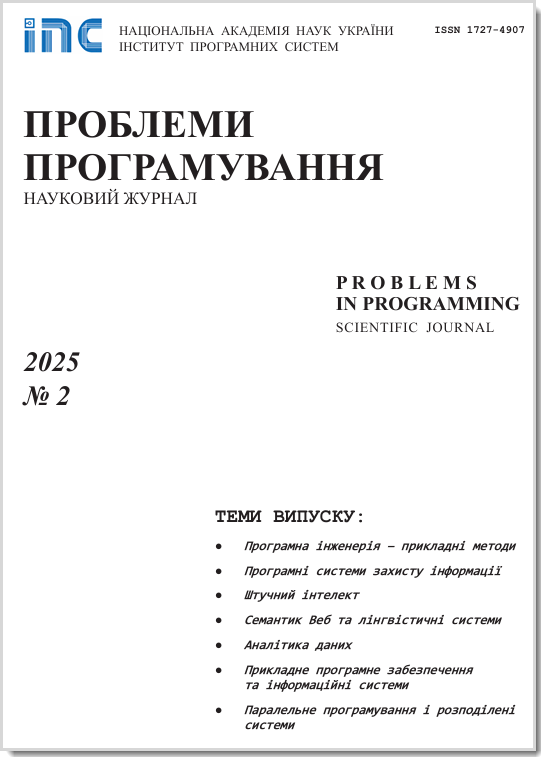Use of thesauruses for search of complex information objects on Web on the basis of ontologies
Abstract
An ontological model of interaction between objects and subjects of the Web semantic search is proposed, its basic elements are characterized, methods for its replenishment and use for filtering information that is pertinent to the personalized needs of users are considered. The types of relations between the instances and classes of this model and their characteristics that can have an influence on the time complexity of processing knowledge presented on the basis of this model, are analyzed. One of the important elements of the proposed model are thesauri that represent knowledge regarding tasks for which users are looking for information, and about information resources where such information can be contained. The expediency of using particular cases of ontology – thesauruses – to find semantically similar information objects is substantiated. The types of thesauruses that are used for semantic search are considered, methods for their replenishment and utilization are proposed, and their characteristics are analyzed. In this paper we proposes an algorithm for the automated construction of simple thesaurus, which is formed on the base of the domain ontology and a natural language description of the user’s problem, and methods for generating composite thesauri that are pertinent to new user tasks which are based on the set of simple thesauruses previously built by user. The expressiveness and computational complexity of the proposed methods which depend on the domain ontology characteristics and on the size of the problem description are estimated. Methods of use of the semantically marked Wiki resources as a source of knowledge for constructing ontologies of subject areas and associated typical information objects are considered.
Problems in programming 2019; 4: 28-52
Keywords
Full Text:
PDF (Українська)References
Baeza-Yates R., A. Raghavan R. (2010) Next generation Web search // S. Ceri and M. Brambilla, editors, Search Computing, Springer, P.11-23. CrossRef
Rogushina J.V. (2015) Semantic retrieval in the Web on base of ontologies: design of methods, means and methods. Melitopol, MDPU. [in Ukrainian].
Ushold M., Gruninger M. (1996) Ontologies: Principles, Methods and Applications, // Knowledge Engineering Review, V.11, N 2. CrossRef
Antoniou G., Van Harmelen F. (2004) Web ontology language: Owl. Handbook on ontologies. Springer Berlin Heidelberg, P. 67-92. CrossRef
Rogushina J.V. Theoretical principles of use of ontologies for semantization of the Web resources. Problems in program-ming. 2018. N 2-3. P. 197-203. CrossRef
Mitchell, T. M. (1997) Machine learning. Burr Ridge, IL: McGraw Hill, 45(37). P. 870-877.
Rogushina J.V. Models and Methods of Ontology Use for the Web Semantic search. Proc. of the 11th International Conference of Programming UkrPROG 2018, P.197-203. - http://ceur-ws.org/Vol-2139/197-203.pdf.
Semantic MediaWiki. https://www.semantic-mediawiki.org/wiki/Semantic_MediaWiki.
Grimes S. (2008) Unstructured Data and the 80 Percent Rule, , Clarabridge, Bridgepoints. http://breakthroughanalysis.com/2008/08/01 /unstructured-data-and-the-80-percent-rule/.
Rogushina J.V. (2017) Use of semantic properties of the Wiki resources for expansion of functional posibilities of "Great Ukrainian Encyclopedia" // Encyclopaedias in the modern information space: collective monograph / Ed. Kyrydon A.M., Kyiv. P. 104-115. [in Ukrainian]
Gladun A., Rogushina J. (2013) Ontology repositories as a means of knowledge reuse for recognizing of information objects // Ontology of Design, № 1 (7). [in Russian]
Resource Description Framework (RDF) Model and Syntax Specification. W3C Proposed Recommendation, 1999. http://www.w3.org/TR/PR-rdf-syntax.
OWL 2 Web Ontology Language Document Overview. W3C. 2009. http://www.w3.org/ TR/owl2-overview/.
DOI: https://doi.org/10.15407/pp2019.04.028
Refbacks
- There are currently no refbacks.




